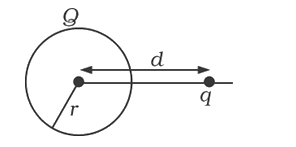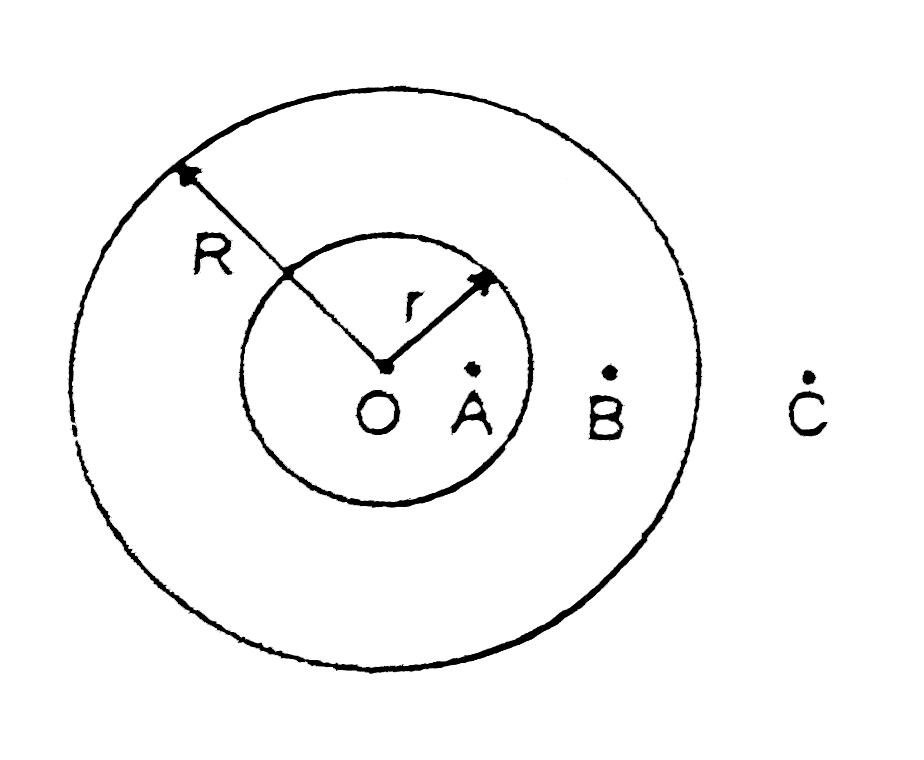Find out electric field intensity due to uniformly charged solid non-conducting sphere of volume charge density ρ and radius R at following points :
(i) At a distance r from surface of sphere (inside)
(ii) At a distance r from the surface of sphere (outside)
The correct Answer is:(i) ρ(R−r)3ε0 (ii) ρR33ε0(r+R)2
To find the electric field intensity due to a uniformly charged solid non-conducting sphere of volume charge density ρ and radius R at two different points, we can use Gauss's law.
1. Identify the distance from the center:
Since we are considering a point inside the sphere, the distance from the center of the sphere will be x=R−r.
2. Calculate the charge enclosed:
The volume of the sphere of radius x is given by:
V=43πx3=43π(R−r)3
The charge enclosed within this volume is:
Qenc=ρ⋅V=ρ⋅43π(R−r)3
3. Apply Gauss's Law:
According to Gauss's law:
∮E⋅dS=Qencϵ0
For a spherical Gaussian surface of radius x, the left side becomes:
E⋅4πx2
Thus, we have:
E⋅4π(R−r)2=ρ⋅43π(R−r)3ϵ0
4. Solve for E:
Cancel 4π from both sides:
E(R−r)2=ρ(R−r)33ϵ0
Therefore,
E=ρ(R−r)3ϵ0
(ii) At a distance r from the surface of the sphere (outside)
1. Identify the distance from the center:
For a point outside the sphere, the distance from the center is x=R+r.
2. Calculate the charge enclosed:
The total charge Q of the sphere is:
Q=ρ⋅43πR3
3. Apply Gauss's Law:
For a spherical Gaussian surface of radius x:
∮E⋅dS=Qϵ0
Thus, we have:
E⋅4π(R+r)2=ρ⋅43πR3ϵ0
4. Solve for E:
Cancel 4π from both sides:
E(R+r)2=ρR33ϵ0
Therefore,
E=ρR33ϵ0(R+r)2
Final Results:
- Electric field intensity inside the sphere (at distance r from the surface):
E=ρ(R−r)3ϵ0
- Electric field intensity outside the sphere (at distance r from the surface):
E=ρR33ϵ0(R+r)2
Since we are considering a point inside the sphere, the distance from the center of the sphere will be x=R−r.
The volume of the sphere of radius x is given by:
V=43πx3=43π(R−r)3
The charge enclosed within this volume is:
Qenc=ρ⋅V=ρ⋅43π(R−r)3
According to Gauss's law:
∮E⋅dS=Qencϵ0
For a spherical Gaussian surface of radius x, the left side becomes:
E⋅4πx2
Thus, we have:
E⋅4π(R−r)2=ρ⋅43π(R−r)3ϵ0
Cancel 4π from both sides:
E(R−r)2=ρ(R−r)33ϵ0
Therefore,
E=ρ(R−r)3ϵ0
For a point outside the sphere, the distance from the center is x=R+r.
The total charge Q of the sphere is:
Q=ρ⋅43πR3
For a spherical Gaussian surface of radius x:
∮E⋅dS=Qϵ0
Thus, we have:
E⋅4π(R+r)2=ρ⋅43πR3ϵ0
Cancel 4π from both sides:
E(R+r)2=ρR33ϵ0
Therefore,
E=ρR33ϵ0(R+r)2
- Electric field intensity inside the sphere (at distance r from the surface):
E=ρ(R−r)3ϵ0
- Electric field intensity outside the sphere (at distance r from the surface):
E=ρR33ϵ0(R+r)2
Topper's Solved these Questions
- ELECTROSTATICSBOOK - RESONANCE ENGLISHCHAPTER - ELECTROSTATICSEXERCISE - Exercise-1 Section (C)
14 Videos
- ELECTROSTATICSBOOK - RESONANCE ENGLISHCHAPTER - ELECTROSTATICSEXERCISE - Exercise-1 Section (D)
5 Videos
- ELECTROSTATICSBOOK - RESONANCE ENGLISHCHAPTER - ELECTROSTATICSEXERCISE - Exercise-1 Section (A)
9 Videos
- ELECTROMAGNETIC INDUCTIONBOOK - RESONANCE ENGLISHCHAPTER - ELECTROMAGNETIC INDUCTIONEXERCISE - A.l.P
19 Videos
- EXPERIMENTAL PHYSICSBOOK - RESONANCE ENGLISHCHAPTER - EXPERIMENTAL PHYSICSEXERCISE - PART -II
10 Videos
Similar Questions
Electric field due to an infinite non-conducting sheet of surface charge density σ, at a distance r from it is
View SolutionThe electric potential due to uniformly charged sphere of radius R,having volume charge density rho having a spherical cavity of radius R2 as shown as in figure at point p is
_PHY_E05_288_Q01.png)
View SolutionThe electric field at 2R from the centre of a uniformly charged non - conducting sphere of rarius R is E. The electric field at a distance R2 from the centre will be
View SolutionFigure shows a uniformly charged thin non-conducting sphere of total charge Q and radius R. If point charge q is situated at point 'A' which is at a distance r<R from centre of the sphere, then find out following :
(i) Force acting on charge q.
(ii) Electric field at centre of sphere.
(iii) Electric field at point B.

View SolutionA solid conducting sphere of radius r is having a charge of Q and point charge q is a distance d from the centre of sphere as shown. The electric potential at the centre of the solid sphere is :

View SolutionFor a uniformly charged non conducting sphere of radius R which of following shows a correct graph between the electric field intensity and the distance from the centre of sphere –
View SolutionThe electric field intensity at a distance 20cm from the centre of a uniformly charged non conducting solid sphere of radius 10cm is E.Then what is the electric field intensity at a distance 5cm from the centre it will be.....
View SolutionA Uniformly charged solid non-conducting sphere of uniform volume charge density ρ and radius R is having a concentric spherical cavity of radius r. Find out electric field intensity at following points, as shown in the figure :

(i) Point A (ii) Point B
(iii) Point C (iv) Centre of the sphere
View SolutionA solid non conducting sphere has charge density pCm−3 Electric field at distance x from its centre is ______ [x<R]
View SolutionA non-conducting solid sphere of radius R, has a uniform charge density. The graph representing variation of magnitude of electric field (E) as a function of distance (x) from the centre of the sphere is

View Solution